There’s something wrong with the desert between Trona and Panamint Springs...maybe even as far as Furnace Creek. The land looks scarred, sick, as if there’s been trouble. Like battles were fought there. It’s all stirred up and grotesque. Someone did something to the terra to make it not so firma, likely early entrepreneurs trying to make money by pulling ore out of the ground. Whoever did it or however it happened, it looks terribly beautiful, breathtaking even.
Calcite, dolomite and many other ites make up hundreds of miles of frothy, salty-looking terrain that will hurt you if you allow it to get too close. Best to view it from a distance—to ride right past it. But that’s not what I did.
You see, I spent the past few days riding and walking into and through it. I let it wash all over me. I’m still brushing the fine borax dust from my boots and old motorbike. So many things come out of the ground up there that I’m not sure what’s in my eyes and hair. Minerals turned my hands chalky white. I realized immediately upon arriving that I hadn’t researched it enough, hadn’t taken it seriously. I’d never been there and no one properly warned me. Everything I’d learned about Death Valley was hearsay, rumors and lies:
“There’s a trove of hidden gold up there somewhere. There are dead bodies everywhere. The hills are alive. Stuff moves at night. The ground is blessed and cursed at the same time. The canyons talk, the sand sings. You’ll get lost if you’re not careful. You’ll find yourself out there.”
And it’s all true.
I tried to count the colors and gave up right quick. The place is a natural palette, alright. You’ll witness the entire spectrum of vibrant and muted colors from the rocks, grass, ground and sky. But those colors meant dollars and since the mid-1800’s, men came looking for them.
Who did this to you? You watched as an unwilling participant, unapproving of the damage being done. So much was taken and yet there’s so much still there, all around, as if you’re saying to those long dead, “Nice try. Please stop it.” And in 2005, the Billie Mine, an underground borax mine along the road to Dante’s View, was the last of Death Valley’s mines to cease operations. I’ll bet your sighs of relief could be heard way over in Beatty.
Extremes? Oh, yeah. I was up high in the snow, I got down low at Badwater. Other souls were there, too, looking for something...and not likely the same thing I was seeking. I passed by many of the well-known sites: The Racetrack, Teakettle Junction, the Charcoal Kilns, Father Crowley’s Overlook, Striped Butte and the Geologists Cabin. I rode up to that ranch where they found Charlie Manson hiding, too. Serene and a bit spooky, like Tex was out there watching me from the trees. But what I enjoyed most were the poorly maintained trails deep in the heart of it all: Saline Valley Road, Goler Wash, Mengel Pass, Lippincott Mine Road...places like that. I thought then of those early miners who carved these roads out of the landscape. Man against nature. Sure must’ve been a lot of dynamite in those days. They wanted to yank every last ounce of value from the earth; the Earth had other plans. The twisted, discarded machinery scattered in seemingly impossible locations hinted at who won.
And I kept riding, absorbing its beauty and its danger. An inattentive moment and a visitor could find himself on the ground. I wasn’t careful and saw the scenery up close. I tasted that gypsum-rich soil on more than one occasion. “Enjoy me, respect me.” Yes, I hear you now.
I left Death Valley knowing I’d only scratched the surface. And I knew that whatever minerals I’d rolled around in had done their work: I wanted to return, to see more, to be there in the quiet, open places. I felt a commonality with the place. I felt comfortable there—not unlike a snake handler or a demolition expert does in their environments. So, enjoy yourself but be careful...because one wrong move and you might remain part of the landscape.
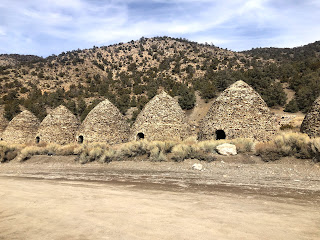

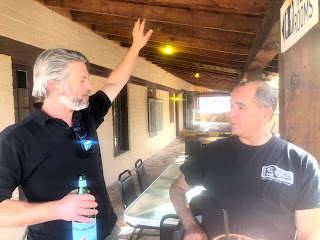
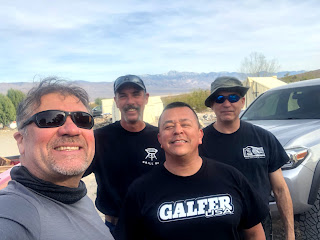










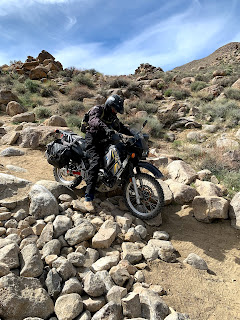

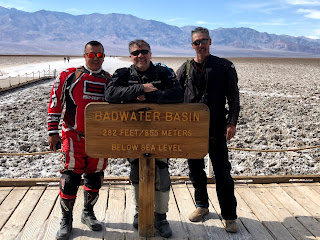





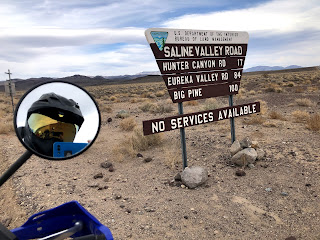












No comments:
Post a Comment